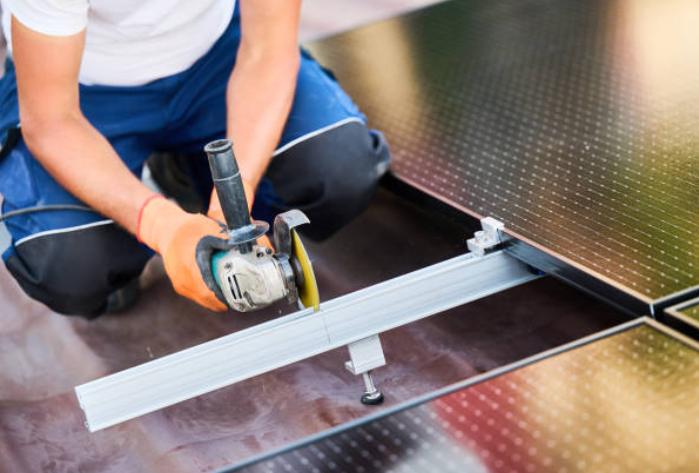Metal roofing stands out as a durable and long-lasting option for roofing projects. However, one of the challenges of working with metal roofing is knowing how to cut it properly. Incorrect cuts can lead to wasted materials, sharp edges, and a poor fit.
Understanding how to cut metal roofing is essential for a successful installation whether you are a DIY enthusiast or a seasoned professional looking to refine your technique.
This guide will walk you through the entire process, from selecting the right tools to ensuring safety and precision in every cut.
Understanding Metal Roofing
It’s important to understand the different types of metal roofing materials available before diving into the cutting process. Common types include steel, aluminum, copper, and zinc.
Each material has its unique properties and benefits, such as durability, longevity, and resistance to weather conditions. Metal roofing is a popular choice due to its energy efficiency, low maintenance, and aesthetic appeal.
Safety Precautions
Safety should always be your top priority when cutting metal roofing. Ensure you wear appropriate personal protective equipment (PPE) such as gloves, safety glasses, and ear protection.
Set up your workspace in a well-ventilated area, free from flammable materials, to prevent any accidents. Secure the metal sheet properly to avoid movement during cutting.
Tools Needed for Cutting Metal Roofing

Manual Cutting Tools
Manual cutting tools include tin snips and hacksaws. Tin snips are ideal for small, precise cuts and come in various types such as straight-cut, left-cut, and right-cut variations.
On the other hand, Hacksaws are useful for cutting through thicker metal sheets but can be labor-intensive.
Power Cutting Tools
Power cutting tools encompass a range of equipment including circular saws, angle grinders, and metal cutting shears. Circular saws are equipped with metal-cutting blades and are excellent for making long, straight cuts quickly.
Angle grinders are effective for both cutting and grinding, though they produce a lot of sparks. Metal cutting shears offer quick, clean cuts with minimal effort.
Choosing the Right Tool for the Job
Consider the thickness of the metal when choosing the right tool the type of cut needed, and your comfort level with the tool. Tin snips are excellent for detailed work, while a circular saw is better for long, straight cuts. Weigh the pros and cons of each tool to determine the best fit for your project.
Preparation Before Cutting
Preparation is key to achieving clean cuts. Measure the metal roofing accurately and mark your cut lines with a permanent marker or chalk. Ensure the metal sheet is well-supported to prevent bending or warping during cutting.
1. Cutting Metal Roofing with Tin Snips

To cut metal roofing with tin snips, begin by measuring and marking the cut line accurately. Select the appropriate tin snips for the job—straight-cut, left-cut, or right-cut based on your needs. Start at the edge of the metal sheet and make small, incremental cuts along the marked line.
Keep the snips straight and avoid twisting them to maintain a clean cut. Using long, smooth strokes and keeping the snips sharp will help achieve a clean finish. Practicing on scrap pieces can also help build confidence and improve your technique.
2. Using a Circular Saw to Cut Metal Roofing

Using a circular saw to cut metal roofing involves several steps. First, fit the saw with a metal-cutting blade. Secure the metal sheet and mark the cut line clearly. Start the saw and let it reach full speed before beginning to cut.
Guide the saw along the marked line steadily, ensuring a straight cut. Safety is paramount when using a circular saw, so wear eye and ear protection, keep both hands on the saw, and allow the blade to stop completely before setting the saw down.
3. Cutting Metal Roofing with an Angle Grinder

To cut metal roofing with an angle grinder, attach a metal-cutting disc to the grinder and mark the cut line on the metal sheet. Hold the grinder firmly and start cutting along the line, moving slowly to control the cut and reduce sparks.
Managing sparks and debris is crucial for safety; wear a full-face shield and protective clothing, work in a well-ventilated area, and clear the workspace of any flammable materials.
5. Using Metal Cutting Shears

Using metal cutting shears involves marking the cut line clearly on the metal sheet. Position the shears at the starting point and squeeze the handles to start cutting, following the line smoothly. Continue cutting until the entire line is complete.
Metal cutting shears produce clean, burr-free cuts with minimal sparks and noise, making them efficient for both straight and curved cuts.
| Tool | Efficiency (1-10) | Ease of Use (1-10) | Safety (1-10) |
|---|---|---|---|
| Tin Snips | 7 | 8 | 9 |
| Hacksaw | 5 | 6 | 7 |
| Circular Saw | 9 | 7 | 6 |
| Angle Grinder | 8 | 6 | 5 |
| Metal Cutting Shears | 9 | 8 | 8 |
Finishing the Cut Edges
After cutting, it’s important to smooth the rough edges to prevent injuries and ensure a professional finish. Use a metal file or deburring tool to smooth out the edges. Applying edge protection, such as a sealant or edge trim, can further enhance safety and durability.
Common Mistakes to Avoid
- Avoid cutting too quickly, as it can lead to jagged edges and mistakes.
- Always double-check your measurements before cutting to ensure accuracy.
- Taking your time and being precise will result in cleaner, safer cuts.
Maintenance Tips for Metal Roofing
- Regular inspections are crucial for maintaining the integrity of metal roofing.
- Check for any signs of rust, loose screws, or damage.
- Clean the roofing periodically to remove debris and prevent buildup that can cause corrosion.
- Promptly repair any issues to extend the life of your metal roof.
Conclusion
Cutting metal roofing requires the right tools, safety precautions, and techniques. You can achieve precise and clean cuts by following the steps outlined in this guide. It ensures a successful roofing project. Remember, practice makes perfect, so take your time and prioritize safety.
People Also Ask (FAQs)
The best tool depends on the type of cut and material thickness. Tin snips are great for small, detailed cuts, while a circular saw or angle grinder is better for longer, straight cuts.
Measure and mark your cut line carefully. Use a straight edge or guide to keep the tool aligned with the line during cutting.
Yes, tin snips come in various types such as straight-cut, left-cut, and right-cut, designed to handle different cutting directions and angles.
Inspect your metal roofing at least twice a year and after any major weather events to check for damage or wear.
You can cut metal roofing yourself If you have the right tools and follow safety precautions. However, hiring a professional is recommended for complex projects.
